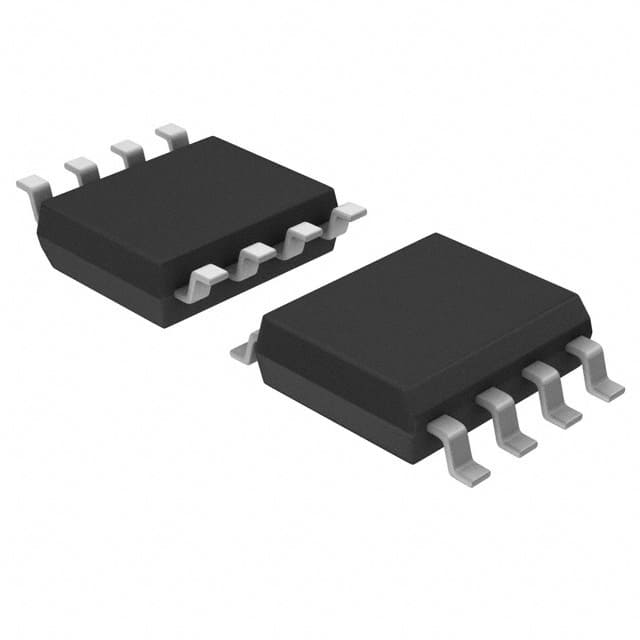Szczegóły produktu można znaleźć w specyfikacjach.

XC17S30VO8I
Basic Information Overview
- Category: Integrated Circuit (IC)
- Use: Programmable Logic Device (PLD)
- Characteristics: High-speed, low-power consumption
- Package: 8-pin Small Outline Integrated Circuit (SOIC)
- Essence: Non-volatile memory technology for programmable logic applications
- Packaging/Quantity: Available in reels of 2500 units
Specifications
- Logic Cells: 30
- Maximum Frequency: 100 MHz
- Operating Voltage: 3.3V
- I/O Pins: 8
- Programming Technology: In-system programmable (ISP)
Detailed Pin Configuration
- VCC: Power supply voltage
- GND: Ground reference
- DIN: Data input
- CS: Chip select
- CLK: Clock input
- DO: Data output
- OE: Output enable
- NC: No connection
Functional Features
- Non-volatile Memory: Retains programmed configuration even when power is removed
- High-Speed Operation: Supports clock frequencies up to 100 MHz
- Low-Power Consumption: Optimized design for energy efficiency
- In-System Programmable: Can be reprogrammed without removing from the circuit board
- Small Form Factor: Compact 8-pin package suitable for space-constrained applications
Advantages
- Flexibility: Allows for custom logic implementation
- Cost-Effective: Eliminates the need for discrete logic components
- Time-Saving: Rapid prototyping and design iterations
- Reliability: Non-volatile memory ensures configuration integrity
Disadvantages
- Limited Logic Capacity: Suitable for small-scale designs only
- Lack of Real-Time Adaptability: Requires reprogramming for logic changes
- Higher Cost per Logic Cell compared to larger PLDs
Working Principles
The XC17S30VO8I is based on non-volatile memory technology, specifically Electrically Erasable Programmable Read-Only Memory (EEPROM). It consists of a matrix of configurable logic cells that can be programmed to implement custom digital logic functions. The device is programmed using specialized software tools that generate a bitstream file containing the desired configuration. This bitstream is then loaded into the XC17S30VO8I via a programming interface, enabling it to function as per the programmed logic.
Detailed Application Field Plans
The XC17S30VO8I is commonly used in various applications where small-scale programmable logic is required. Some typical application fields include: 1. Consumer Electronics: Control logic for appliances, gaming devices, and multimedia systems. 2. Industrial Automation: Programmable control units for machinery and equipment. 3. Automotive Electronics: Custom logic implementation for automotive systems. 4. Communication Systems: Interface logic for networking and telecommunications equipment. 5. Medical Devices: Control and monitoring logic for medical equipment.
Detailed and Complete Alternative Models
- XC17S15VO8I: 15 logic cells, otherwise similar specifications.
- XC17S50VO8I: 50 logic cells, increased logic capacity.
- XC17S100VO8I: 100 logic cells, higher density PLD option.
Note: The above alternative models are part of the same XC17S series and share similar features and pin configurations.
This entry provides an overview of the XC17S30VO8I, a programmable logic device with 30 logic cells. It includes information about its basic characteristics, pin configuration, functional features, advantages, disadvantages, working principles, application field plans, and alternative models.
Wymień 10 typowych pytań i odpowiedzi związanych z zastosowaniem XC17S30VO8I w rozwiązaniach technicznych
Sure! Here are 10 common questions and answers related to the application of XC17S30VO8I in technical solutions:
Q: What is XC17S30VO8I? A: XC17S30VO8I is a specific model of programmable logic device (PLD) manufactured by Xilinx.
Q: What are the key features of XC17S30VO8I? A: XC17S30VO8I offers 30,000 usable gates, 256 macrocells, and operates at a voltage of 3.3V.
Q: What are some typical applications of XC17S30VO8I? A: XC17S30VO8I can be used in various applications such as digital signal processing, telecommunications, industrial control systems, and automotive electronics.
Q: How does XC17S30VO8I differ from other PLDs? A: XC17S30VO8I stands out due to its high gate count, large number of macrocells, and low power consumption.
Q: Can XC17S30VO8I be reprogrammed after it has been configured? A: No, XC17S30VO8I is a one-time programmable (OTP) device and cannot be reprogrammed once it has been configured.
Q: What programming languages can be used with XC17S30VO8I? A: XC17S30VO8I can be programmed using Hardware Description Languages (HDLs) such as VHDL or Verilog.
Q: Is XC17S30VO8I compatible with other Xilinx devices? A: Yes, XC17S30VO8I is compatible with other Xilinx devices and can be integrated into larger systems.
Q: What is the maximum operating frequency of XC17S30VO8I? A: The maximum operating frequency of XC17S30VO8I depends on the specific design and implementation, but it can typically reach several hundred megahertz.
Q: Can XC17S30VO8I interface with external memory devices? A: Yes, XC17S30VO8I supports various memory interfaces such as SRAM, SDRAM, and Flash memory.
Q: Are development tools available for programming XC17S30VO8I? A: Yes, Xilinx provides a range of development tools, including software compilers, simulators, and programming hardware, to facilitate the programming and integration of XC17S30VO8I into technical solutions.
Please note that the answers provided here are general and may vary depending on the specific requirements and use cases.

